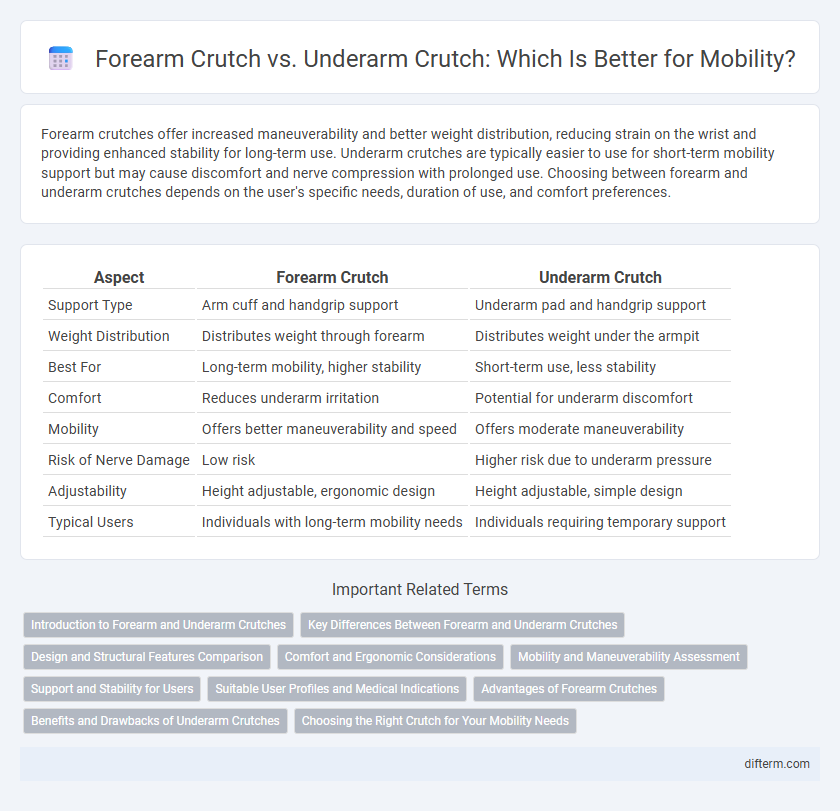Forearm crutches offer increased maneuverability and better weight distribution, reducing strain on the wrist and providing enhanced stability for long-term use. Underarm crutches are typically easier to use for short-term mobility support but may cause discomfort and nerve compression with prolonged use. Choosing between forearm and underarm crutches depends on the user's specific needs, duration of use, and comfort preferences.
Table of Comparison
| Aspect | Forearm Crutch | Underarm Crutch |
|---|---|---|
| Support Type | Arm cuff and handgrip support | Underarm pad and handgrip support |
| Weight Distribution | Distributes weight through forearm | Distributes weight under the armpit |
| Best For | Long-term mobility, higher stability | Short-term use, less stability |
| Comfort | Reduces underarm irritation | Potential for underarm discomfort |
| Mobility | Offers better maneuverability and speed | Offers moderate maneuverability |
| Risk of Nerve Damage | Low risk | Higher risk due to underarm pressure |
| Adjustability | Height adjustable, ergonomic design | Height adjustable, simple design |
| Typical Users | Individuals with long-term mobility needs | Individuals requiring temporary support |
Introduction to Forearm and Underarm Crutches
Forearm crutches provide increased mobility and support by featuring a cuff that wraps around the forearm, allowing for better weight distribution and improved arm positioning. Underarm crutches, also known as axillary crutches, offer stability through padded supports placed under the armpits, making them suitable for short-term use and weight-bearing relief. Both types enhance mobility but differ in design, comfort, and suitability depending on the user's specific needs and mobility goals.
Key Differences Between Forearm and Underarm Crutches
Forearm crutches provide greater mobility and control by allowing users to maintain an upright posture and engage the forearm cuff for support, ideal for long-term use and active individuals. Underarm crutches, also known as axillary crutches, distribute weight through the armpits, offering more stability but potentially causing discomfort or nerve damage with prolonged use. The choice between forearm and underarm crutches depends on factors like balance needs, upper body strength, and duration of use, with forearm crutches favored for agility and underarm crutches preferred for short-term stability.
Design and Structural Features Comparison
Forearm crutches feature a cuff encircling the forearm and a handgrip, offering enhanced arm support and better weight distribution, while underarm crutches rest under the armpit with padded top supports and adjustable height settings for stability. Forearm crutches typically use lightweight materials like aluminum or carbon fiber, providing greater maneuverability and reduced user fatigue compared to the bulkier, typically steel-based underarm crutches. Structurally, the forearm design allows for increased mobility and coordination, whereas underarm crutches prioritize upper body strength for balance and shock absorption.
Comfort and Ergonomic Considerations
Forearm crutches offer enhanced ergonomic benefits by promoting better posture and reducing strain on the wrists and shoulders, making them ideal for long-term use. Underarm crutches, while often easier to use initially, can cause discomfort and nerve compression in the underarm area due to prolonged pressure. Selecting forearm crutches typically leads to improved comfort during extended mobility, as they distribute weight more evenly and allow for greater arm movement.
Mobility and Maneuverability Assessment
Forearm crutches offer superior mobility and maneuverability by allowing greater arm freedom and better weight distribution, facilitating smoother movement on uneven surfaces. Underarm crutches provide more stability but can limit upper body mobility and cause discomfort during prolonged use, impacting overall maneuverability. For users requiring agility and extended movement, forearm crutches enhance adaptive mobility, while underarm crutches are better suited for short-term or less intense mobility needs.
Support and Stability for Users
Forearm crutches provide enhanced support through ergonomic grips and forearm cuffs that distribute weight evenly while allowing greater mobility and balance control. Underarm crutches offer stability by transferring weight to the upper body and under the arms, which can lead to pressure and discomfort with prolonged use. Users seeking prolonged use and improved maneuverability often prefer forearm crutches for optimal support and stability.
Suitable User Profiles and Medical Indications
Forearm crutches are suitable for individuals with long-term mobility impairments, such as those with cerebral palsy, multiple sclerosis, or stroke, providing better arm support and increased mobility independence. Underarm crutches are generally recommended for short-term use in cases of lower limb injuries like fractures or post-surgical recovery, offering greater weight-bearing support but requiring good upper body strength. Medical indications for forearm crutches emphasize improved ergonomics and reduced risk of nerve damage, while underarm crutches are preferred for stability and ease of use during initial rehabilitation stages.
Advantages of Forearm Crutches
Forearm crutches offer enhanced maneuverability and greater upper body strength engagement, making them ideal for users requiring long-term support and improved posture. These crutches reduce the risk of nerve damage and discomfort associated with prolonged underarm pressure found in underarm crutches. Lightweight and ergonomically designed, forearm crutches also facilitate better balance and mobility on uneven terrains, supporting active lifestyles and rehabilitation.
Benefits and Drawbacks of Underarm Crutches
Underarm crutches provide upper body support and stability, allowing users to bear weight on their arms and reduce stress on injured legs. They are easy to adjust and maneuver, making them suitable for short-term use or less severe mobility impairments. However, prolonged use can cause discomfort in the armpits, potential nerve damage, and poor posture, leading to muscle fatigue and secondary complications.
Choosing the Right Crutch for Your Mobility Needs
Selecting the appropriate crutch depends on weight distribution, comfort, and mobility goals with forearm crutches offering greater maneuverability and reduced underarm pressure essential for long-term use. Underarm crutches provide stability and ease of use, particularly suitable for short-term mobility support and for individuals who require more weight-bearing assistance. Evaluating user strength, balance, and terrain compatibility ensures an optimal choice that enhances mobility and minimizes the risk of injury.
Forearm crutch vs Underarm crutch Infographic

 difterm.com
difterm.com